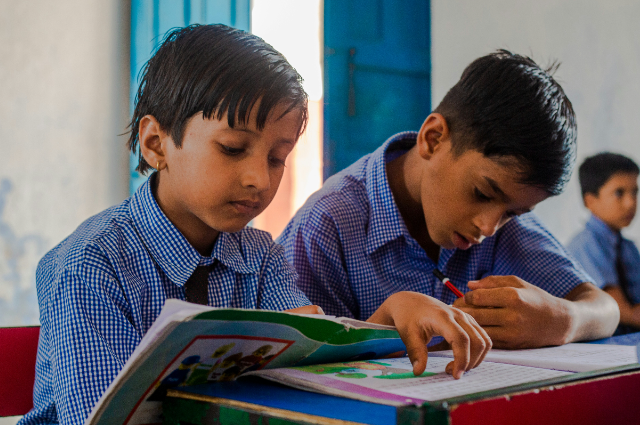
The strength of our society isn’t only seen in its wealth, rising GDP, or technology. It’s in how it treats its weakest and vulnerable members. In India, three crucial groups often stand out and demand our special attention, as needing special support: children, youth, and the elderly. Each faces a different stage of life. Children are fully dependent, youth are in transition, and old age often brings decline and insecurity. Traditionally, families carried all the responsibility. But today, with the rapid urbanisation, migration, and changing lifestyles, families can’t always manage alone and cannot provide every form of care. This is where programmes, institutions, and community services step in. From anganwadis to youth camps to old-age homes, they fill the gaps that families can’t and hold society together.
Support Systems for Children
Children form one-third of India’s population, which makes their welfare a national priority and a matter of compassion. But they’re also a highly vulnerable section of our society. If they are neglected, the results are harsh: malnutrition, school dropouts, child labour, even trafficking and abuse. And these consequences often last a lifetime.
India has built several systems to protect them. The Juvenile Justice Act (2000) gives special care to children in conflict with the law or those in need of protection. Instead of punishment, the focus is on rehabilitation. One of the most remarkable welfare programmes, more like another pillar, is the Integrated Child Development Services (ICDS), which was launched in 1975. It is considered the largest early childhood care initiative in the world. Through lakhs of anganwadis, it provides children, nutrition, vaccination, pre-school teaching, and health check-ups. It reaches millions of children and their mothers. It not only saves lives but also lays a foundation for better learning and growth of children.
Alongside government efforts and schemes, NGOs step in, which play a strong role. For instance, SOS Children’s Villages offers abandoned kids family-like homes. The Central Adoption Resource Authority (CARA) regulates adoption so that children can find safe families. There are also State-run children’s homes that provide food, shelter, and vocational training for those who have no family support. Many NGOs and community initiatives also fight against child labour, trafficking, and abuse. And offers rescue, counselling, and rehabilitation to them.
These aren’t just welfare measures. They’re investments in the future, making sure the next generation has the health and skills to build our society.
Support Systems for Youth
Youth is broadly between 15 and 29 years. It stands at a turning point. They’re energetic and ambitious but also face serious struggles like exam stress, unemployment, addiction, peer pressure, and mental health issues. Rural and tribal youth often deal with a lack of opportunities, which makes them even more at risk.
To guide them, several programmes exist. The National Service Scheme (NSS) brings college students into community projects, giving them leadership skills and social awareness. The Nehru Yuva Kendras focus on rural youth, involving them in literacy, training, and development activities. Traditional groups like Scouts and Guides still teach them discipline, teamwork, and patriotism.
Adventure programmes like trekking, mountaineering, and canoeing are also promoted to build courage and resilience in them. On a wider scale, India hosts the Asia-Pacific Centre of the Commonwealth Youth Programme in Chandigarh, which focuses on ICT, peace-building, and similar vocational skills. Cultural exchanges and youth camps further promote unity in a diverse country.
Together, these institutions help young people not only prepare for jobs but also become active, responsible citizens. With India’s youth population so massive, this support is critical for stability and progress.
Support Systems for the Elderly
Old age brings its own problems, like a decline in health, financial stress, and isolation. Also, diseases like arthritis, cataracts, and dementia are so common. Moreover, children move to cities, and joint families are breaking down; many seniors are also left without daily care.
To support them, India adopted the National Policy on Older Persons (1999). It ensures healthcare, shelter, and social opportunities for elderly people. The National Old Age Pension Scheme (NOAPS) provides small pensions to poor seniors who are above 65. Though modest, it’s a lifeline for many.
There are also old-age homes, day-care centres, and long-term nursing facilities. Mobile Medicare Units bring doctors to villages. Special centres for dementia patients offer relief to both seniors and their families. Emotional support comes through counselling centres and helplines for abused or lonely elderly.
These services may not be perfect, but they’re vital. They bring dignity back into a stage of life that often gets ignored.
Children need care, youth need direction, and the elderly need dignity. Together, all of these represent India’s past, present, and future. Government programmes like ICDS, NSS, and NOAPS, with some other NGOs such as SOS Villages and adoption agencies, build a safety net that families alone cannot provide for everyone.
But challenges remain, such as not every service reaches every corner, and resources are stretched thin. Even so, the progress shows that India recognizes its duty to protect the vulnerable. A nation cannot call itself fully developed if its children suffer, its youth drift aimlessly, or its elderly are abandoned. Real progress comes when each stage of life is secured with care, opportunity, and respect for everyone.
